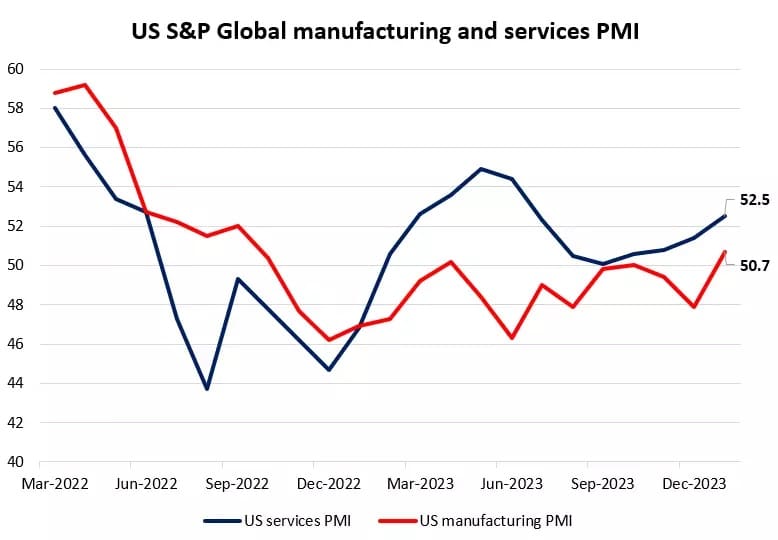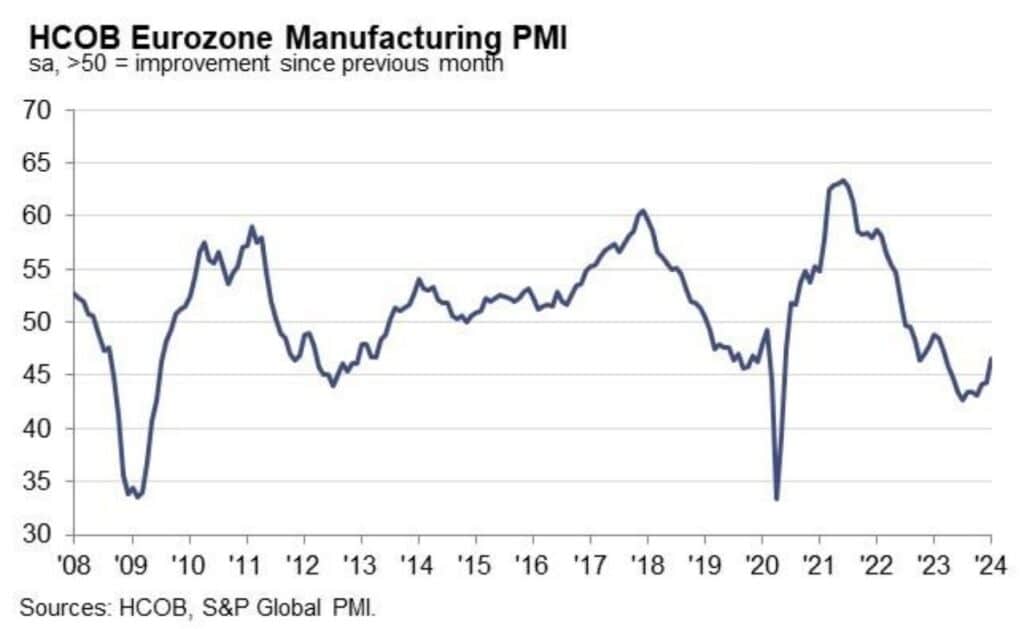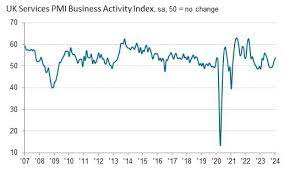What to Expect from the US S&P Global PMI Releases
As the U.S. S&P Global PMI releases approach, scheduled for 14:45 GMT on Thursday, February 22nd, 2024, analysts are anticipating crucial insights into the country’s economic performance. Consensus forecasts suggest a slight moderation in the S&P Global Services PMI for February, with expectations set at 52, down from last month’s 52.5. Experts anticipate a similar trend in the S&P Global Manufacturing PMI data, with consensus figures pointing to 50.2 from the previous month’s 50.7.

The upcoming flash PMI surveys are eagerly awaited to gauge further signs of economic improvement globally. January data already indicated growth reaching a six-month high in the United States, prompting expectations for continued resilience. The Citigroup surprise gauge’s significant ascent suggests analysts might be underestimating the strength of the U.S. economy, potentially leading to unexpectedly positive outcomes. This could further diminish expectations for rate cuts, bolstering the U.S. dollar against major currencies like the euro and British pound as interest rate divergence widens.
What to Expect from the Eurozone, Germany and France HCOB PMI Releases
As the HCOB PMI releases for France, Germany, and the Eurozone approach, scheduled for 8:15, 8:30, and 9:00 GMT respectively on Thursday, February 22nd, 2024, market observers are closely anticipating several key indicators. Consensus forecasts for France’s HCOB Manufacturing PMI in February stand at 44, reflecting a modest improvement from last month’s 43.1, while the Services PMI is expected to inch up to 45.6 from 45.4, with the Composite PMI at 45.5 compared to 44.6 previously.
In Germany, expectations are for the Manufacturing PMI to rise to 46.1 from 45.5, the Services PMI to increase to 48 from 47.7, and the Composite PMI to edge up to 47.4 from 47. Meanwhile, for the Eurozone, consensus forecasts project a slight uptick across the board, with the Manufacturing PMI expected to reach 47.1 from 46.6, the Services PMI to rise to 48.7 from 48.4, and the Composite PMI to increase to 48.5 from 47.9.

Following January’s tentative signs of improvement in the HCOB PMI survey, which showed softened contractions in business activity and new orders alongside strengthened growth expectations, investors are hopeful for further positive developments. Despite mixed country-level data, with improvements noted in southern economies like Italy but contractions worsening in Germany and France, overall sentiment suggests a possible improvement in the business cycle. However, amidst inflationary dynamics and high data volatility, achieving a reduction in inflation from 3% to 2% will likely necessitate thoughtful monetary policy decisions and balanced trade-offs.
What to Expect from the UK S&P Global PMI Releases
As the UK S&P Global PMI releases approach, scheduled for 9:30 GMT on Thursday, February 22nd, 2024, analysts are closely monitoring several key indicators. Consensus forecasts suggest a marginal uptick in the S&P Global Services PMI for February, with expectations at 54.4, a slight increase from last month’s 54.3. There is also a slight rise anticipated for the S&P Global Manufacturing PMI, with consensus figures at 47.1, from the previous month’s 47. The S&P Global Composite PMI, encompassing both services and manufacturing, is expected to moderate to 52.7 from last month’s 52.9.

These releases hold significant weight in the broader economic context, especially following the recent GDP data revealing a worse-than-expected contraction in the UK economy in the last quarter of the year. The PMI data is critical in assessing whether the UK is truly “turning a corner” economically, as claimed by the prime minister. Additionally, these figures will impact the chancellor’s decisions ahead of the upcoming Budget, where tax cuts are anticipated. Moreover, the Bank of England’s policy decisions are influenced by these economic indicators, particularly concerning wage and price pressures, notably in the services sector. With a “tight” labour market and significant wage growth observed, the Bank may lean towards maintaining rates rather than implementing cuts.
What is Manufacturing, Services and Flash PMI
Manufacturing, Services, and Flash Purchasing Managers’ Index (PMI) are key economic indicators used to gauge the health and performance of different sectors within an economy.
Manufacturing PMI: This index measures the activity level of the manufacturing sector within an economy. It is based on surveys conducted among purchasing managers in manufacturing companies, who provide insights into various aspects such as production levels, new orders, employment, supplier deliveries, and inventories. A PMI reading above 50 indicates expansion in the manufacturing sector, while a reading below 50 suggests contraction.
Services PMI: Similar to Manufacturing PMI, Services PMI focuses on the services sector, which encompasses industries such as hospitality, finance, healthcare, and transportation, among others. This index also relies on surveys of purchasing managers in service-providing companies to assess factors like business activity, new orders, employment trends, and business expectations. A Services PMI above 50 signifies growth in the services sector.
Flash PMI: Flash PMI, or preliminary PMI, provides an early indication of the direction of economic activity before the final PMI data is released. It is based on a subset of the full PMI survey and is typically released one week ahead of the final PMI figures. Flash PMI offers timely insights into economic trends and is closely watched by investors, policymakers, and analysts for indications of economic growth or contraction.
These PMI indicators play a crucial role in assessing the overall economic health, providing valuable insights into the performance of key sectors and helping stakeholders make informed decisions regarding investment, monetary policy, and business strategies.
Why are PMI Releases Important
PMI releases hold significant importance for investors, policymakers, and businesses due to several key reasons:
Timeliness: PMI releases provide timely information about the economic activity in different sectors, often before official government data becomes available. As leading indicators, PMI surveys offer insights into current economic conditions, allowing stakeholders to make informed decisions promptly.
Gauging Economic Health: PMI data offer a snapshot of economic health by assessing the level of business activity, new orders, employment trends, and output levels in both manufacturing and services sectors. A PMI reading above 50 indicates expansion, while a reading below 50 suggests contraction. These indicators help in assessing the overall economic momentum and identifying potential shifts in growth or contraction.
Forecasting GDP Growth: PMI releases are closely correlated with gross domestic product (GDP) growth. By analysing PMI trends, economists and investors can forecast the direction and pace of GDP growth. Strong PMI readings often precede robust economic expansion, while declining PMI figures may signal an economic slowdown or recession.
Market Impact: PMI releases can significantly impact financial markets. Positive PMI data indicating economic expansion may lead to increased investor confidence, driving stock prices higher and strengthening the local currency. Conversely, weaker-than-expected PMI figures may trigger market volatility, as investors interpret them as signs of economic weakness, potentially leading to stock market declines and currency depreciation.
Policy Implications: Central banks and policymakers closely monitor PMI releases to assess the need for monetary policy adjustments. Strong PMI readings may prompt central banks to consider tightening monetary policy to prevent overheating, while weak PMI data may prompt policymakers to implement stimulus measures to spur economic activity.
Business Planning: For businesses, PMI data provide valuable insights into demand conditions, allowing them to adjust production levels, inventory management, and workforce planning accordingly. By understanding prevailing economic trends through PMI surveys, businesses can make informed decisions to optimise operations and mitigate risks.
PMI releases are essential economic indicators that offer timely and comprehensive insights into economic conditions, aiding investors and traders who may try to trade the news, policymakers, and businesses in making informed decisions and navigating the dynamic economic landscape.